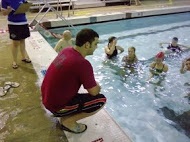
Seizures can occur anywhere and at any time, so it is crucial that a first aider learns what to do in case of such an emergency. One of the most important first aid procedures that one can learn is how to attend to a victim who has seizures while in water. Loss of consciousness is critical in many conditions, and becomes intensified when a patient is in water. A seizure while in water is potentially fatal especially because it is almost impossible to tell when a seizure will occur. What’s more, there are many water sources around us, whether you are looking at a lake in the outdoors, a dip in the swimming pool or a bath in the tub.
[youtube url=”https://www.youtube.com/watch?v=4qWPFCFmRlI” width=”220″]If you notice someone having seizures while in water, make sure to follow the steps outlined below. Remember that quick action could help save a life.
i) Reach out to the individual as soon as you can.
ii) Support the victim while still in the water. At this point, you must make sure that the head is tilted at an angle. This is so as to make sure that the face and head remain above the surface of the water. The importance of this action is manifested in that the victim does not drown and is therefore able to continue breathing.
iii) Seizures are characterized by sudden jerking movements so it is imperative to make sure that the victim is constantly above the water. While at it, it is important to ensure that you estimate the timing of the seizures while in water. This will come in handy should the need for professional medical attention arise.
iv) Once the sudden jerking movements cease, you should get the individual out of water immediately.
v) Once on dry ground, check to see whether the victim is breathing, and if there is a pulse. If the victim is not breathing, but has a pulse rate, the first aider should embark on giving CPR. There are two types of CPR that one can give a victim who has had seizures while in water. The first is the conventional type of CPR that incorporates mouth to mouth resuscitation while the second involves provision of hand CPR. The latter is preferred since quite a number of people are hesitant to give mouth-to-mouth rescue breaths.
vi) If you are not well versed with first aid procedures to be administered following the occurrence of a seizure, it is recommended that you call for help even as an operator gives you a step by step guide to the same.
vii) Even after the victim has made a recovery, first aiders are advised to call for professional medical help since there is a chance that the victim could have inhaled water which can easily lead to damage of the lungs and heart.
Take note that if an individual experiences seizures while in water, and during water activities it is imperative that they do not partake in such activities for the rest of the day.
